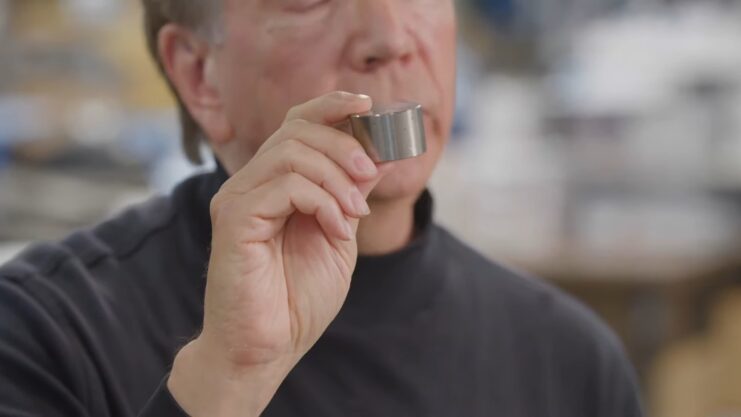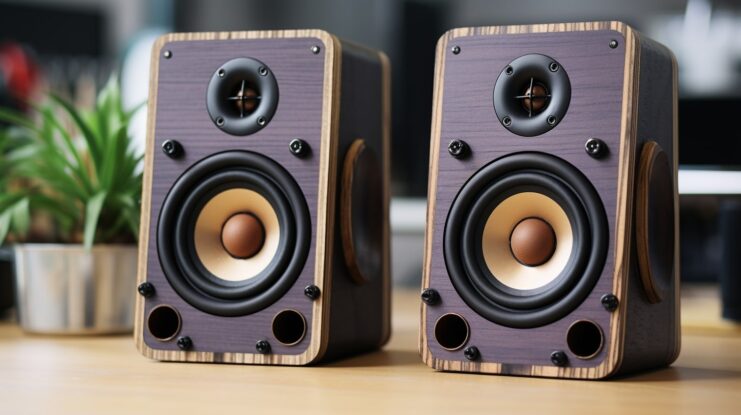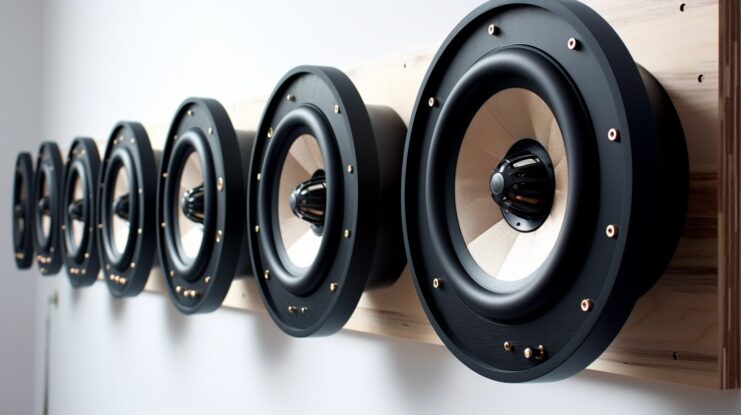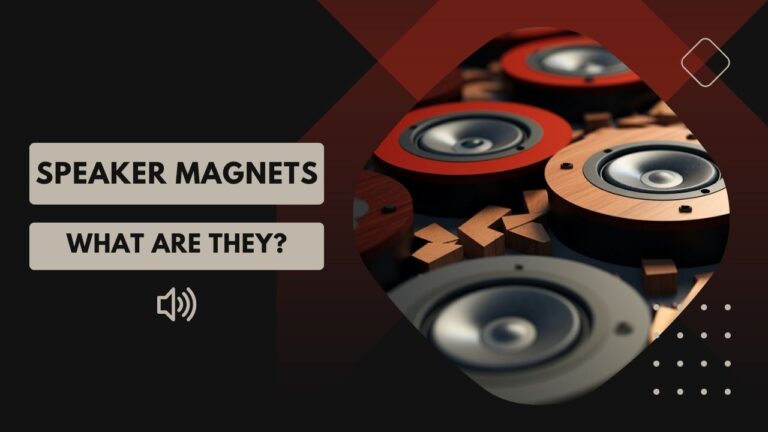Speaker magnets are an essential part of any loudspeaker system. They work by creating a magnetic field that interacts with the speaker coil to produce sound waves.
But what exactly do they do? How do they influence the quality and volume of sound? Whether you’re an audiophile or someone simply curious about the mechanics behind your favorite tunes, understanding the function of speaker magnets can offer a fascinating insight.
In this blog post, we will discuss their different types, how they work, and how they affect the sound quality of a speaker.
Types
Speaker magnets play a crucial role in the functioning of speakers, converting electrical energy into sound. There are primarily two types: permanent magnets and electromagnets.
Permanent

- Composition: Crafted from materials like ferrite, alnico, or neodymium, permanent magnets have made a significant mark in the audio industry.
- Characteristics: What sets them apart is their inherent ability to maintain a steady magnetic field without relying on an external power source.
- Advantages: Their dominance in the speaker world can be attributed to their cost-effectiveness and the simplicity of their production process.
- Limitations: However, they don’t boast the strongest magnetic fields, especially when compared to their electromagnet counterparts.
- Sound Quality: If you’re a fan of warmer tones, speakers equipped with permanent magnets might just be your best bet.
Electromagnets

- Composition: At the heart of an electromagnet lies a coil of wire, meticulously wrapped around a metal core.
- Characteristics: These magnets spring to life, generating a magnetic field, when an electric current courses through the coil.
- Advantages: The magnetic field strength they can achieve is unparalleled, especially when juxtaposed with permanent magnets.
- Limitations: Their need for an external power source can be a double-edged sword, offering superior performance but potentially hiking up system costs.
- Sound Quality: If brighter sound profiles resonate with you, electromagnets are the way to go.
How Do They Work
The speaker magnet, positioned at the rear of the speaker, is connected to the speaker cone via a suspension system. Here’s a step-by-step breakdown of its operation:
- Signal Application: When an electrical signal is introduced to the speaker coil, it induces a magnetic field.
- Magnetic Interaction: This newly formed magnetic field interacts with the pre-existing magnetic field of the speaker magnet.
- Cone Movement: The interplay between these magnetic fields propels the speaker cone to oscillate back and forth.
- Sound Production: As the speaker cone moves, it generates sound waves that we perceive as sound.
- Loudness Determination: The magnitude of the magnetic field produced by the speaker magnet dictates the sound’s volume. A more substantial magnetic field results in a louder sound.
- Sound Quality: The kind of speaker magnet can influence the speaker’s sound quality. As mentioned earlier, permanent magnets usually deliver a warmer sound, whereas electromagnets produce a brighter tone.
How to Choose

When exploring the realm of audio systems, it becomes imperative to familiarize yourself with the speaker magnet, an indispensable element. The magnet you select can greatly impact the speaker’s audio quality, volume, and overall efficacy.
However, with a multitude of choices at your disposal, determining the correct magnet can be perplexing. Let’s explore the factors that you should take into consideration.
Two Main Types
- Permanent Magnets: These are the go-to choice for those on a budget. Made from materials like ferrite, alnico, or neodymium, they have a fixed magnetic field that doesn’t require an external power source. They’re ideal for smaller speaker systems, offering a warmer sound quality.
- Electromagnets: If you’re aiming for top-tier sound quality without much concern for the budget, electromagnets should be on your radar. Comprising a coil of wire wrapped around a metal core, they generate a magnetic field when an electric current passes through. Electromagnets are especially suited for larger speaker systems, given their ability to produce a brighter and more potent sound.
Factors to Consider When Buying
- Size of the Speaker System: If you’re setting up a compact system, permanent magnets will likely meet your needs. But for more extensive setups, the strength of electromagnets becomes essential to deliver the required sound output.
- Desired Sound Quality: Your preference between a warmer or brighter sound will determine your choice. Permanent magnets lean towards the former, while electromagnets offer the latter.
- Budget Constraints: Permanent magnets are generally more wallet-friendly, making them a popular choice among many audio enthusiasts. Electromagnets, while pricier, offer superior sound quality.
- Type of Speaker: The kind of speaker you’re setting up, be it a bookshelf speaker, floor-standing speaker, or subwoofer, will also influence your decision.

Benefits
Speaker magnets are integral to the functioning of audio systems. They generate the magnetic field responsible for moving the speaker cone, which in turn produces sound waves.
Besides their fundamental role, they are cost-effective and versatile, fitting into various speaker systems, from petite bookshelf units to grand floor-standing ones.
Drawbacks
While speaker magnets are indispensable, they come with their set of challenges. They can be quite hefty, making speaker transportation a task.
Their fragility demands careful handling, and their susceptibility to other magnetic fields means they need to be stored away from other magnets.
FAQs
How to care for speaker magnets?
To maintain the longevity and performance of your speaker magnets, handle them with care to avoid damage. Ensure they’re stored away from other magnets to prevent interference with their magnetic fields.
For cleaning, use a soft cloth and avoid harsh chemicals. Proper care will keep your speaker magnets in prime condition for years.
Watch this video if you’re interested in how to remove magnet so you can clean it:
What are the safety concerns with speaker magnets?
Speaker magnets come with certain safety considerations. Firstly, they pose a risk to small children; if ingested, a magnet can attract other metallic objects inside the body, leading to severe injuries.
Additionally, those with medical devices, such as pacemakers, should maintain distance from these magnets, as they can disrupt the functioning of such devices. Lastly, electronic devices can be adversely affected if placed too close to speakers with magnets, as the magnetic field can interfere with their operation.
Closing Thoughts
Speaker magnets are an essential part of any loudspeaker system. They work by creating a magnetic field that interacts with the speaker coil to produce sound waves.
The type of speaker magnets you choose will depend on your budget, the desired sound quality, and the size of the speaker system. By understanding how speaker magnets work, you can choose the right ones for your speaker system and get the best possible sound quality.
Related Posts:
- How To Tell If Your Speakers Are Blown - Your Handy…
- How To Connect Multiple Bluetooth Speakers -…
- How To Connect Banana Plugs To Speakers - Plug In & Play
- What Is A Good Frequency Response For Speakers - A…
- How To Connect Speakers To A Projector? Say Goodbye…
- Top 11 Best Computer Speakers With Subwoofer 2024 -…







